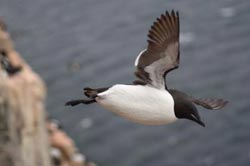Diving seabirds: Working hard and living long

Brünnich's guillemots have the highest flight costs of any bird. Credit: Kyle Elliott<br>
The guillemots – which look similar to penguins but can fly – have the highest flight costs of any bird and expend substantial energy for diving. Their high metabolisms and frequent dives should produce oxidative stress, causing the birds to deteriorate as they age. But, the researchers discovered that the birds stay fit and active as they grow older, maintaining their flying, diving, and foraging abilities.
Kyle Elliott, a PhD student at the University of Manitoba and the study's lead author, said, “Most of what we know about aging is from studies of short-lived round worms, fruit flies, mice, and chickens, but long-lived animals age differently. We need data from long-lived animals, and one good example is long-lived seabirds.”
Elliott also said, “Not only do these birds live very long, but they maintain their energetic lifestyle in a very extreme environment into old age.”
One bird, nicknamed 'Wayne Gretzky' by the researchers (after the Canadian hockey great who played 20 seasons and because the bird's identification band colours matched Gretzky's team colours), raised young for 18 consecutive years.
Over 4 consecutive summers, researchers periodically tracked Brünnich's guillemots' fitness, recording how deep and for how long they would dive for prey, how far and fast they would fly, and how much energy they expended on these activities. They looked for changes in the birds' behaviour and metabolism.
Media Contact
More Information:
http://www.sebiology.org/All latest news from the category: Life Sciences and Chemistry
Articles and reports from the Life Sciences and chemistry area deal with applied and basic research into modern biology, chemistry and human medicine.
Valuable information can be found on a range of life sciences fields including bacteriology, biochemistry, bionics, bioinformatics, biophysics, biotechnology, genetics, geobotany, human biology, marine biology, microbiology, molecular biology, cellular biology, zoology, bioinorganic chemistry, microchemistry and environmental chemistry.
Newest articles

A universal framework for spatial biology
SpatialData is a freely accessible tool to unify and integrate data from different omics technologies accounting for spatial information, which can provide holistic insights into health and disease. Biological processes…

How complex biological processes arise
A $20 million grant from the U.S. National Science Foundation (NSF) will support the establishment and operation of the National Synthesis Center for Emergence in the Molecular and Cellular Sciences (NCEMS) at…

Airborne single-photon lidar system achieves high-resolution 3D imaging
Compact, low-power system opens doors for photon-efficient drone and satellite-based environmental monitoring and mapping. Researchers have developed a compact and lightweight single-photon airborne lidar system that can acquire high-resolution 3D…





















